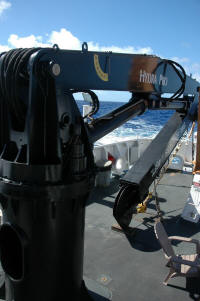Deck Crane
Walking around the harbors in the North West was a great way to see a bunch of cranes on fishing and work boats. (1) I preferred the knuckle crane's or sometimes call a articulated crane, because they can raise and lower items while keeping the hoist cables short so as to avoid the load from swinging. Unfortunately they are very expensive and small, used ones are hard to find. (2) The more tradition boom cranes on the other hand are plentiful as they are frequently use on service trucks. We found ours in the City of Tulsa surplus auction for $2,450 and it came with an 89 Ford Super Duty pickup. The truck was in really bad shape but it will still have some salvage value in it. The crane is an Auto Crane 5005H with a Ramsey's winch, both manufactured right here in Tulsa, Oklahoma. New this crane sells for $14,000. I'm glad we found this crane before we had started building the hull, because at 12 feet long, it is too big to fit perpendicular to the beam as originally intended. Instead we will modify the port cabin side of the cargo hull so that the boom can be stowed down the port side of the cabin. Documentation for Auto Crane 5005 - The old ones. With 80 feet of cable on the winch, a lifting capacity of 2,500 pounds at 10 feet, and 1,250 at 20 feet, this crane will give use access over both the port and starboard sides of the boat. I actually got the truck to start, and it runs pretty good. The cranes hydraulics are powered from a pump that has an electric clutch connecting it to the engine. It needs to spin at 950 rpm but I am not sure what it's HP requirement is. The initial test is not good. The hydraulic system is dry, indicating that the City likely abandoned an attempt to fix a problem. We added fluid back and the system does not leak but nothing works either so we suspect the pump. A gauge will soon be added to test that.
The pump should supply a minimum of 6 GPM at 2,350 PSI Northern Tool: High Pressure Hydraulic Clutch Pump, 2.32Cu In, Maximum pressure 3000. 1 1/4in. NPTF inlet, 1in. NPTF outlet. 11.6 GPM @ 1200 RPM, about $520 (4) For now the cane is resting peacefully beside the building pad. It weighs about 1,200 pounds so it's not going anywhere without some work. By the way, that's old carpet we got for free underneath the crane. It's an excellent way to keep the grass down.
|

